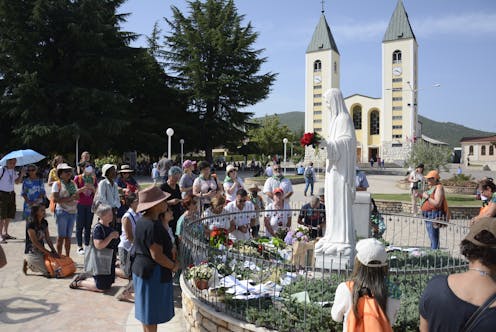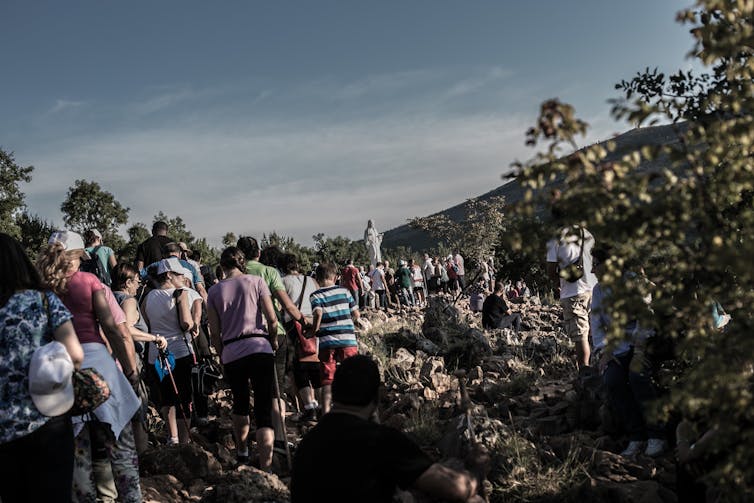How updated Vatican rules on validating supernatural appearances of Mary will affect the famed pilgr
The Vatican has said that the pilgrimage to Medjugorje, a small town in Bosnia-Herzegovina, can yield ‘spiritual benefits’ but refrained from calling the apparitions genuinely supernatural.

For over 40 years, six people from Medjugorje, a small town in Bosnia-Herzegovina, have claimed to see and speak with the Virgin Mary. For almost as long, hordes of pilgrims have traveled to visit sites of the virgin’s alleged appearance and to observe the seers’ daily trances.
The Vatican has never approved the pilgrimage or issued any official judgment of the visionaries – until now.
Scholars have shown that Christians have claimed to see the virgin in dreams and visions since the fourth century. I have studied modern Marian apparitions for about 15 years and wrote a book about an American apparition.
Reports of Virgin Mary sightings escalated after 1800. Church leaders have rarely authenticated such claims, however, with the exception of some famous events at Lourdes, France, and Fátima, Portugal.
Of the roughly 500 apparitions reported between 1900 and 2000, the Catholic Church declared only 10 to be genuinely supernatural, based on the church’s exacting requirements for authenticity.
Earlier this year, though, the Dicastery for the Doctrine of the Faith – formerly the Inquisition and now the Vatican office responsible for protecting and promoting Catholicism – issued new norms for the discernment of alleged supernatural events.
As a result, the dicastery has declared that despite its previous skepticism, the pilgrimage to Medjugorje can still yield “spiritual fruits.” The decision does not mean, however, that the dicastery believes the apparitions to be genuinely supernatural – only the pope can make that decision.
Still, both the ruling and the way it came about are important changes in the history of apparitions.
Apparitions at Medjugorje
In 1981, Medjugorje was a small farm town of about 14,000 people in the former Yugoslavia. On June 24 that year, six children, aged 11 to 16, told their families that they had seen the Gospa – Serbo-Croatian for the “Lady” – on the hill of Podbrdo near Medjugorje.
Forty-three years later, two of the original witnesses still claim to see and speak to the Gospa daily, while three of the others allegedly meet her yearly, and one announced that she no longer sees the virgin. The two who see the Gospa daily, Ivan Dragicevic and Vicka Ivankovic-Mijatovic, continue to share the virgin’s daily messages with pilgrims.
Church authorities have argued about the Medjugorje apparitions since they began. They sent psychiatrists and physicians to examine the seers, tested the children’s grasp of the catechism and observed their behavior. Meanwhile, more people came to watch the daily visions, even when Yugoslavia was fractured into new nations by the three-year-long Bosnian war starting in 1992.
The Gospa has allegedly imparted about 40,000 messages to the seers, which have been shared on various websites devoted to the Medjugorje pilgrimage. The sheer number of repetitive messages alarmed church authorities. In 2017, Pope Francis warned that Mary was “not a Madonna who is the head of a telegraph office.”
The messages claim that Mary wants a return to faith, conversion to deeper forms of Catholicism, ordination of more priests and reconciliation among individuals, families and nations. According to seers, the virgin also chided Catholics for not paying attention to her messages at Medugorje.

Church guidelines for discernment
The church has always set guidelines for discerning the truth of visions. A seer must be healthy and their visions must not contradict Catholic doctrine.
Additionally, the seer must not seek profit or fame from their experiences or use visionary claims as a pretext for exploitation. They must not spread “a sectarian mentality” that would subvert church authority.
Until now, local bishops investigated reports of supernatural phenomena in their dioceses, then either declared them safe for Catholics or shut them down. Sometimes a complex case led bishops to seek private help from the dicastery.
The process varied across dioceses and could take years to complete – 43 in the case of Medjugorje. If the church finds nothing troubling about the proclaimed visionary, Catholics are allowed but not required to believe in the vision.
New norms
The dicastery’s revised norms of discernment may be a response to increasing Catholic claims to supernatural experience. Global media not only spread but encourages reports of visions and apparitions.
The newly revised norms make three important changes to the process.
First, the new norms put the decision about supernatural phenomena in the hands of the dicastery. It streamlines the process and prevents local politics or any single bishop’s opinions from clouding final assessment of the declared apparition.
Second, the dicastery has reduced assessment of visions to one of six outcomes. The least positive decision is that there’s nothing supernatural going on.
The most positive ruling – short of the pope’s official declaration that the phenomenon is unarguably supernatural – is “Nihil obstat,” meaning “nothing hinders.”
This means the event presents “many signs of the action of the Holy Spirit,” and that the visionary shows no serious flaws that would prevent Catholics from supporting the phenomenon.
The third is that the apparition can be genuine even if the alleged seers have made minor errors of interpretation or behavior. It recognizes that visionaries sometimes cannot properly articulate what they see, or they may misinterpret the virgin – for instance, suggesting Mary is angry with those who ignore her warnings. Seers need not be perfect Catholics, either.
Belief in the Virgin of Medjugorje
Despite personal criticisms of the seers, such as accusations that they have profited from their fame, the dicastery found that apparitions at Medjugorje have led to profound “positive fruits” for thousands of people.
One survey at the vision site found that 48.8% of visitors to Medjugorje said their lives were changed by the experience; 30.4% believed their lives were “very much” changed; and 14.5% said they were “radically” changed.
Granted, pilgrims are often predisposed to spiritual growth, yet the majority of visitors to Medjugorje claimed deepened faith. Some were moved to seek ordination or able to conquer what they considered sinful habits; some others reconciled with family members, were healed of illness or disability, or witnessed small miracles.
Still, the dicastery suggests that pilgrims should visit and pray at places associated with the “original events” at Medjugorje, such as the hill of Podbrdo, rather than watching the seers in trance.
A Vatican commission in 2010 had decided that the first seven apparitions and related messages were supernatural, but the commission was not convinced about the rest.
Why now?
Changes in the norms for discernment have come at a moment when church leaders claim to be listening to ordinary believers. Pope Francis recently concluded a three-year Synod on Synodality that brought parish priests, lay people and even dissenting theologians together with church leaders in Rome to ponder solutions.
Long-term issues important to the laity, such as inclusion of LGBTQ+ Catholics and women’s ordination, were discussed but left unresolved. Yet the synod achieved some structural reforms aimed at including the ideas and opinions of regular Catholics. Early in the deliberations, the synod itself warned against the “sin … of lack of listening, communion, and participation of all.”
Perhaps the dicastery is paying attention to the experience of pilgrims.

No matter what the supposed visionaries do or say or whether the virgin appears there or not, many visitors say going to Medjugorje makes them better Catholics. Over 43 years, millions of pilgrims have believed in the apparitions at Medjugorje.
It appears that, given the dicastery’s recent ruling of “Nihil obstat,” nothing prevents Catholics from devotion to Our Lady of Medjugorje, the Queen of Peace.
Lisa Bitel does not work for, consult, own shares in or receive funding from any company or organization that would benefit from this article, and has disclosed no relevant affiliations beyond their academic appointment.
Read These Next
How to reduce gift-giving stress with your kids – a child psychologist’s tips for making magic and a
Depending on family circumstances and a child’s personality type, gift giving runs the gamut of fun…
Medieval peasants probably enjoyed their holiday festivities more than you do
The Middle Ages weren’t as dreary and desperate as you’d think, and peasants often had weeks of…
How C-reactive protein outpaced ‘bad’ cholesterol as leading heart disease risk marker
C-reactive protein – a marker of inflammation – is as easily measured with blood work in a doctor’s…





